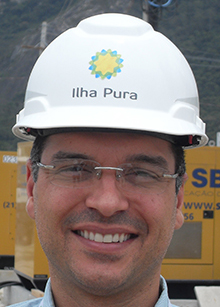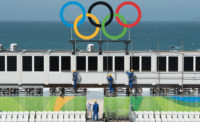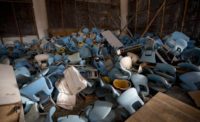Five independent teams have been created to enable the work to be done simultaneously, says Maurício Cruz, engineering director for the Olympic and Paralympic Village project in Brazil. Four teams are taking care of an eight-tower condo cluster, while a final team is assigned to build out the area's infrastructure. The civil work includes site preparation, utility work, a 65,000-sq-meter central park and a 20,000-sq-m swimming pool.
The strategy aims to turn a difficult project into several manageable ones. "The objective of dividing the team was to make the undertaking a regular one," Cruz says. "Building 31 towers simultaneously in one single area is something unusual, extraordinary. So, we chose to split the team."
Each team has its own jobsite manager, production manager and safety engineer as well as commercial and financial departments. Each group also has its own storeroom, infirmary and restaurant. The contractor consortium, composed of Carvalho Hosken and Odebrecht Realizações Imobiliárias, began work on the athletes' village at the beginning of 2012.
The athletes' village will take up a 247,000-sq-m area in the western region of Rio near the Olympic Park. The village is part of a larger, 870,000-sq-m mixed-use development called Ilha Pura, which is expected to take 10 years to complete. The project, estimated to cost $1.02 billion, is being funded with private resources.
 |
| CRUZ |
Work to pave the streets and for basic sanitation and electricity has been assigned to the Rio Mais consortium of Odebrecht Infrastructure, Andrade Gutierrez and Carvalho Hosken, the same group that is building the Olympic Park.
Standing at one million cu m of material, earthmoving at the athletes' village is complete. While workers now total 1,300, the workforce will grow to 5,000 when construction hits its peak later this year.
Due to shallow underground water at the site, a diaphragm wall averaging 10 m high has to be built to allow foundation work to proceed. Just one condo has started to move upward. Three other condos have completed foundation work, and footings are going in for two more towers.
The 31 residential buildings each will have 3,604 apartments with two, three or four bedrooms. The project will house up to 17,950 professional athletes, physically challenged athletes, coaches and physical therapists. The village, scheduled to be delivered by December 2015, also will include retail space.
On-Site Materials
To reduce the number of trucks coming and going, the contractor consortium assembled a Schwing Stetter two-module concrete plant. The plant has a 1,500-cu-m-per-day production capacity to meet peak demand, but it is currently producing just a little less than half its potential. Today, the jobsites are pouring 900 cu m per day of concrete. The job will require a total of 343,000 cu m of concrete.








Post a comment to this article
Report Abusive Comment